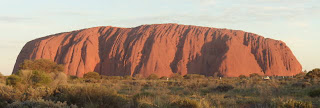Uluru, a/k/a Ayers Rock: a colossal hunk of sandstone rock in the middle of nowhere, yet the most recognizable Australian natural feature and a World Heritage site. We have a big confession. We don't know which of our pictures to post. We could post, for example, the classic sunset picture.
Or, we could post the classic sunrise picture(s).
And then there is the mob of tourists taking pictures of Uluru at sunrise.
Alternatively, we could post the arty pictures that show the grey face of Uluru that is rarely seen.
Or one that shows the orange bluffs highlighted against a blue sky.
Or Amy's arty collage of Aboriginal cave drawings.
The bottom line: Uluru was fascinating. We visited the Uluru-Kata Tjuta Cultural Center, with some interesting exhibits on the lives of the Aboriginals and some of their dreamtime (creation) stories. We particularly liked the story of the guy who finished off an emu that had been hunted and wounded by another hunter. He told the original hunter that the emu had fled in a different direction, hiding the fact that he had eaten it. When the original hunter discovered the falsehood, he came in pursuit of the miscreant, who suffered a terrible death. Roger was reminded of the story in his grandparents' town, Devises, in Wiltshire. A woman who had stolen money denied and said "If I am lying, may the Lord strike me down." He did.
We never got to climb Uluru; it was "closed" the day we were there allegedly due to high winds. Thirty six people have died climbing the rock, and many others have been rescued by the Flying Doctor Service (see later). But we did get a picture of the climbing site (hang onto the rail):
We did, however, do the trail to the waterhole of Mutijulu, where we learned the Aboriginal legend of Kuniya Tjukurpa (Python Dreaming): aWoma Python (Kuniya) traveled from hundreds of kilometres east to Uluru, where it lived in the rocks at Uluru and fought the Liri, the poisonous snakes. Signs of the struggle (and of the snake and python) are still evident in the rock.
We also did the Mala walk and learned the story of the Mala (Hare Wallaby) people who once lived at Uluru, and visited Kantjy Gorge, a waterhole and old hunting ground.
But there is never enough time.








Just realized a lot of these sceneries remind me of Georgia O'Keefe paintings.
ReplyDelete